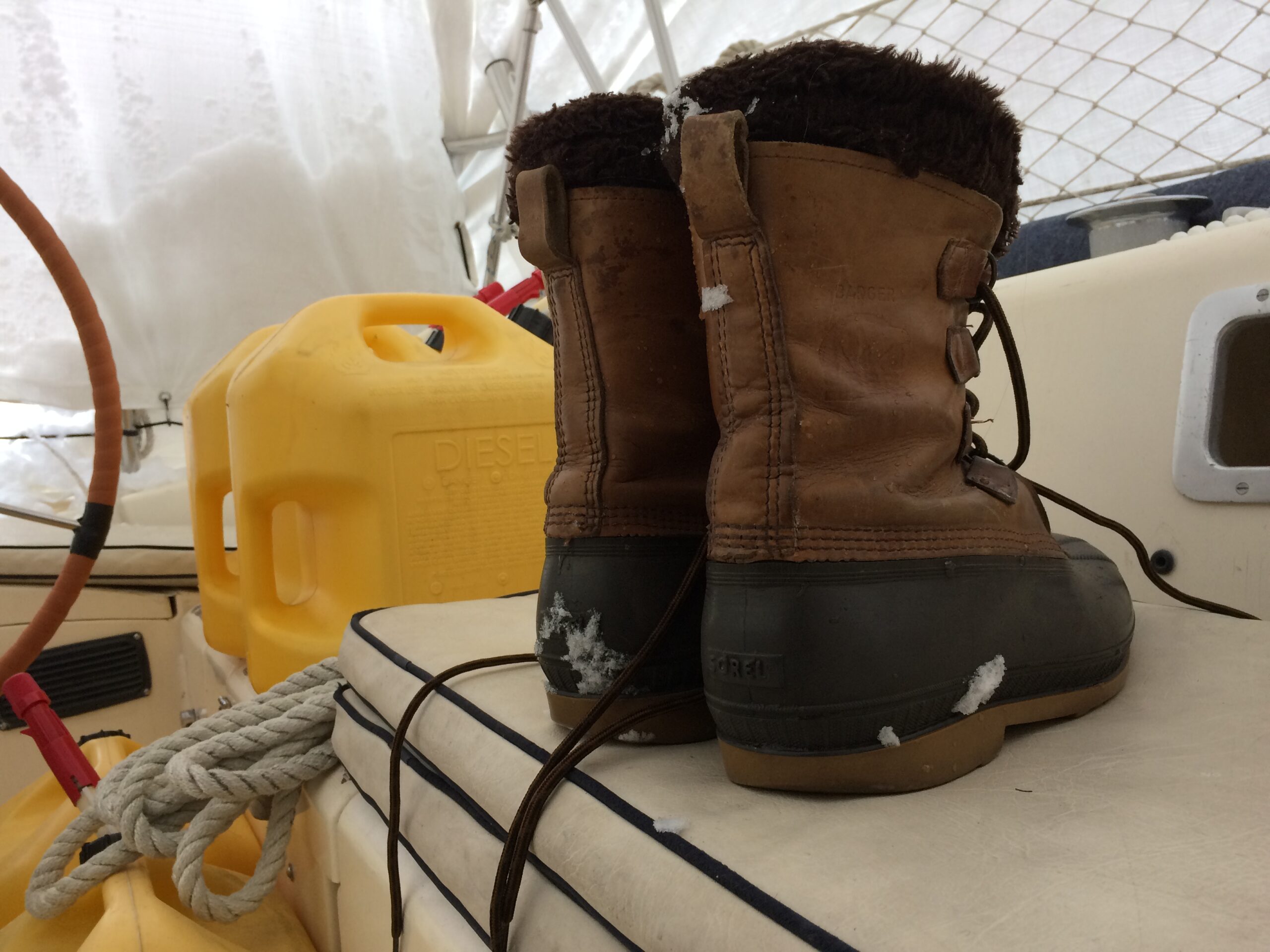In the blogpost, Sérénité: Winter Preparations 1, I discussed one of the steps I had taken to minimize heat loss. Now that it’s officially Winter, the big battle is shaping up to be managing humidity onboard. The thing to understand is that most sailing yachts are not intended for year-round use and, as such, are not insulated to any great extent. So, the hull gets very cold and the moisture in the warm inside air condenses on the cold surfaces. The greatest worry with all this excess moisture, aside from damaging woodwork, electronics, etc., is mold. My boat does have a small amount of insulation in the form of foam-backed vinyl lining in the cabins, teak paneling on the walls, etc., but the R value of these is pretty low. So, the first order of business was to try to bolster the insulation in key areas and get the moisture under control.
Taming the Moisture while Retaining Heat
My search for a candidate insulation material began and ended at my local Home Depot. I was looking for something that was relatively thin, flexible, and easy to cut and handle. After considering several types of material I settled on Reflectix. As an experiment I insulated the lower wall of one the aft cabins and left the other cabin uninsulated. During a particularly cold day I compared the two and there was a noticeable reduction in the condensation in the insulated cabin. Yay Reflectix! I then insulated the remaining cabins. The photos below show the insulation temporarily installed over the vinyl cabin lining. When warmer weather arrives I will be moving the insulation to under the liners where it will not be seen. This task has to wait till spring because good ventilation is required for the adhesive that I will use for the permanent installation.



Insulating both helped the condensation problem in the cabins and reduced heat loss through the hull, but that alone wasn’t enough – it was still too humid aboard. The next step was to eliminate the sources of excess moisture. Another liveaboard reminded me that water is one of the byproducts of the combustion of propane so, I purchased a small electric hot plate to use instead of the gas range during the winter. Now I have the option of cooking things that require boiling a lot of water – like pasta – up on deck during the daytime or using the hotplate down below instead of the propane stove.
The last piece of the puzzle was the addition of a dehumidifier under the v-berth in the forward cabin. This location was chosen because it is in front of the HVAC air intake. Thus, by running the system’s fan, air from throughout the boat can be circulated past the dehumidifier.


Slippery Dock Precautions
There are a variety of configurations for docks at marinas. The marina where Sérénité is docked uses finger piers for access to the side of the boat where you board. Finger piers are narrow walkways about 46 cm (~18 inches) wide that extend from the main dock. When these ice over in winter they can be treacherous to negotiate and falling into the freezing water this time of year can be fatal – fortunately there are measures one can take to minimize the risk.
Taking a page from Ice Climbers (and the advice of a neighbor) I purchased a “consumer” version of cramp-ons to use on my shoes and boots. These ice-cleats (Stabilicers®) stretch onto footware and provide sharp steel teeth that prevent slipping. To prevent damaging the deck of the boat, I found some inexpensive rubber matting that I could cut to fit the entry area. This created a place, out of the weather where I could sit to don and doff the cleats.




What if the power goes out? (and staying warm)
Sailing yachts are meant to be “off the grid” for extended periods while cruising and/or making passage. Presently, Sérénité is equipped with a house battery bank capable of running the systems for several days without recharge, a wind generator to keep the batteries charged and, in a pinch, the auxiliary engine serves as a 100 amp diesel generator (which can also charge the batteries). My future plans include the addition of a photovoltaic array (solar) to supplement the boat’s power generation capabilities. With respect to heat, Sérénité is equipped with a diesel hydronic heating system – a type of radiant heating system that circulates hot glycol to convectors throughout the boat. So, as long as the onboard 12 volt DC system is powered and there’s diesel in the tank I have heat. In addition to the main tank that holds ~135 litres, I keep another 95 litres of diesel fuel on deck in Jerry cans as my emergency reserve.
You might be wondering what it takes to keep an un-insulated boat at a comfortable temperature during sub-zero weather. Well, basically it’s a brute-force approach, the hydronic system is capable of putting out about 31,000 BTU per hour of heat when required – enough for a large apartment on land. On the coldest days (about -12°C so far) the system has been able to keep the boat at 23°C (73°F). What’s funny is that I’ll sometime find the resident duck flock nestled around the hull at the waterline on the leeward side of the boat (the side away from the wind). I’ve been trying to get a picture of this, but as soon as I come up on deck and step onto the finger pier to snap a photo they startle and swim away.






Location: Onboard Sérénité, Back Creek, Annapolis, Maryland, United States, North America
Altitude: 0.50 m

